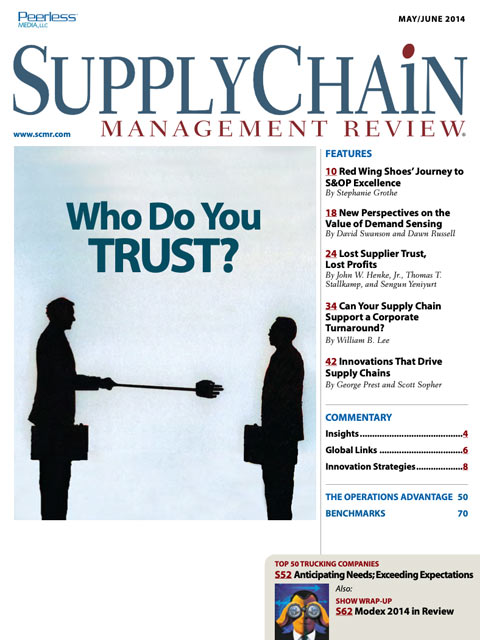Sorry, but your login has failed. Please recheck your login information and resubmit. If your subscription has expired, renew here.
May-June 2014
Getting the most from Sales and Operations Planning is a combination of people, processes, and technology. The Red Wing Shoe Company details the steps it took to improve S&OP processes, slash its S&OP planning efforts by 50 percent, and align manufacturing with sales—all while growing its business. Browse this issue archive.Need Help? Contact customer service 847-559-7581 More options
Supply chain managers are justifiably concerned about the recent consolidation of ocean carrier services, but an even greater threat to their operations may be lurking ahead. According to a new AlixPartners study, many of the major international players face more financial distress—even possible bankruptcy.
Esben Christensen, director of the business advisory firm, says that listed companies have been troubled for the past three years.
“Our analysis suggests that the number of parties controlling containerized transportation on critical trades is shrinking through operational alliances and—potentially in the future—through carriers exiting the business,” he says.
Contributing mightily to this situation, says the study, is a so-so global economy that still hasn’t bounced back from the downturn following the worldwide financial crisis of 2008-2009 the way other post-recession economies have in the past. However, the study also points to several structural issues also buffeting the industry. These include a drive to build “mega vessels,” and fill key trade lanes with these new ships. This represents a trend that over the past decade has steadily increased leverage across the industry and has left it with an average EBITDA interest-coverage rate of just 4.9. This is less than half the rate it was in 2011 (10.8) and less than a third of what it was in 2010 (15.0).
 |
This complete article is available to subscribers
only. Click on Log In Now at the top of this article for full access. Or, Start your PLUS+ subscription for instant access. |
Not ready to subscribe, but need this article?
Buy the complete article now. Only $20.00. Instant PDF Download.
Access the complete issue of Supply Chain Management Review magazine featuring
this article including every word, chart and table exactly as it appeared in the magazine.
SC
MR
Sorry, but your login has failed. Please recheck your login information and resubmit. If your subscription has expired, renew here.
May-June 2014
Getting the most from Sales and Operations Planning is a combination of people, processes, and technology. The Red Wing Shoe Company details the steps it took to improve S&OP processes, slash its S&OP planning… Browse this issue archive. Access your online digital edition. Download a PDF file of the May-June 2014 issue.
 |
Download Article PDF |
Supply chain managers are justifiably concerned about the recent consolidation of ocean carrier services, but an even greater threat to their operations may be lurking ahead. According to a new AlixPartners study, many of the major international players face more financial distress—even possible bankruptcy.
Esben Christensen, director of the business advisory firm, says that listed companies have been troubled for the past three years.
“Our analysis suggests that the number of parties controlling containerized transportation on critical trades is shrinking through operational alliances and—potentially in the future—through carriers exiting the business,” he says.
Contributing mightily to this situation, says the study, is a so-so global economy that still hasn’t bounced back from the downturn following the worldwide financial crisis of 2008-2009 the way other post-recession economies have in the past. However, the study also points to several structural issues also buffeting the industry. These include a drive to build “mega vessels,” and fill key trade lanes with these new ships. This represents a trend that over the past decade has steadily increased leverage across the industry and has left it with an average EBITDA interest-coverage rate of just 4.9. This is less than half the rate it was in 2011 (10.8) and less than a third of what it was in 2010 (15.0).
 |
SUBSCRIBERS: Click here to download PDF of the full article. |
SC
MR

Latest Supply Chain News
- Despite American political environment, global geopolitical risks may be easing
- Joseph Esteves named CEO of SGS Maine Pointe
- Employees, employers hold divergent views on upskilling the workforce
- April manufacturing output slides after growing in March
- Q1 sees a solid finish with positive U.S.-bound import growth, notes S&P Global Market Intelligence
- More News
Latest Podcast

 Explore
Explore
Latest Supply Chain News
- Despite American political environment, global geopolitical risks may be easing
- Joseph Esteves named CEO of SGS Maine Pointe
- Employees, employers hold divergent views on upskilling the workforce
- April manufacturing output slides after growing in March
- Q1 sees a solid finish with positive U.S.-bound import growth, notes S&P Global Market Intelligence
- World Trade Centers offers a helping hand to create resilient, interconnected supply chains
- More latest news
Latest Resources

Subscribe

Supply Chain Management Review delivers the best industry content.

Editors’ Picks





